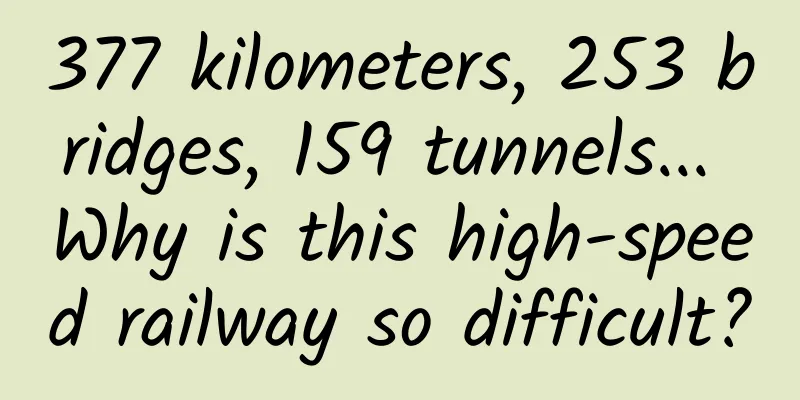377 kilometers, 253 bridges, 159 tunnels... Why is this high-speed railway so difficult?

|
At 10:18 on December 22, 2010, the No. 4806 train departed from Hubei Enshi Railway Station and sped eastward. Thus, the curse of "road construction restricted zone" was broken, the history of "the road to Shu is difficult, more difficult than climbing to the sky" was rewritten, and my country's high-speed railway network successfully crossed the natural barrier and advanced into Sichuan. This railway was the Yiwu-Wanzhou Railway, which was known as "the most difficult railway to build in China" at that time. On December 22, 2010, the first train passed through Badong Railway Station of Yiwu-Wanzhou Railway. Photo: Hao Tongqian, Xinhua News Agency The Yichang-Wanzhou Railway is 377 kilometers long, starting from Yichang East Station in Hubei in the east and ending at Wanzhou Station in Chongqing in the west. It has a total of 13 stations. It is one of the main skeletons of my country's railway network of "eight vertical and eight horizontal". It is an important part of the Shanghai-Wuhan-Chengdu High-Speed Railway, the longest of the "four horizontal and four vertical" high-speed railway networks in my country. It is also a major land route to the east to the sea from my country's western region. This railway, which is less than 400 kilometers long, has been a long-awaited project for the Chinese people for a hundred years. After the official restart of construction, it took another seven years. What stories are behind it? 1 A railway brought down a dynasty “The mountain roads here have eighteen bends, the waterways here are nine linked together… winding and twisting, winding and twisting, all surrounding the water and mountains of the Tujia people.” The folk song sings about the beautiful mountains and rivers of Enshi, and also tells the dilemma of the local lack of access by land and water. In the 23,900 square kilometers of Enshi land, there are three mountain ranges: Wuling Mountain, Wushan Mountain and Dalou Mountain. Before the completion and opening of National Highway 318, the Yangtze River waterway in Badong was the only channel for Enshi to enter Sichuan, connect Yichang and Wuhan, and go to the outside world. Building a railway became the wish of the people of Enshi. In fact, more than a hundred years ago, the railway construction army tried to open up this "railway restricted area" and build the famous Sichuan-Hankou Railway, and the Yiwu-Wanzhou Line was part of it. In the late Qing Dynasty, Kang Youwei, Liang Qichao and other knowledgeable people first proposed the idea of building the Sichuan-Hankou Railway. In 1903, in order to implement the "New Deal", the Qing government allowed the China Merchants Steam Navigation Company to collect merchant shares and establish railway and mining companies. The newly appointed Sichuan Governor Xiliang took this opportunity to request to run the Sichuan-Hankou Railway and established the Sichuan-Hankou Railway Company the following year. In 1909, Zhan Tianyou, who had just completed the construction of the Beijing-Hankou Railway, led his men to Yichang and started construction of the Yichang to Zigui section. The section runs from Yichang along the north bank of the Yangtze River, through Xiaoxita, Wudu River, Daxiakou, Xiangxi to Zigui, with a total length of 160 kilometers. The mountains along the route are undulating and steep, making construction extremely difficult. It was the biggest bottleneck in the construction of the Sichuan-Hankou Railway and the predecessor of the Yiwu-Wanzhou Railway. After the railway construction started, Sichuan people who had suffered from traffic jams participated enthusiastically. At the peak, the number of workers in the entire railway construction exceeded 40,000. In just one year, the 7.5-kilometer-long roadbed from Yichang Railway Dam to Xiaoxi Tower was basically completed. Just when the construction was in full swing, in April 1911, the Qing government signed a loan contract with Britain, France, Germany and the United States to build the railway, announcing that the railway would no longer be operated by private enterprises, but would be nationalized, and the right of way would be sold and the railway would be built with loans. The construction of the Sichuan-Hankou Railway was interrupted. The Qing government’s “treasonous behavior” aroused strong dissatisfaction among the people of Sichuan. Under the cry of “The Sichuan-Hankou Railway is finished! Sichuan is finished, China is finished!”, the Railway Protection Movement broke out in June 1911. This vigorous patriotic action did not successfully save the Sichuan-Hankou Railway, but it promoted the outbreak of the Wuchang Uprising and ignited the fuse of the Xinhai Revolution. It was described by historians as "a road that toppled a dynasty." After the Revolution of 1911, in order to implement Sun Yat-sen's "Industrial Plan", the Sichuan-Hankou Railway construction plan was mentioned again, and then the construction of the eastern section from Hankou to Changjiang Port began. However, at that time, due to the domestic warlords' melee, economic depression, fundraising difficulties, and the subsequent Anti-Japanese War, the construction of the railway progressed very slowly. By 1942, only 39% of the Chengdu-Chongqing section of the Sichuan-Hankou Railway had been completed. In 1964, after the founding of the People's Republic of China, a "Three-Line Construction" project covering 13 provinces and autonomous regions in central and western China, involving large-scale national defense, science and technology, industry, electricity and transportation, kicked off. Railway construction became the forerunner in the construction, and the Sichuan-Hankou Railway once again attracted attention. However, "the national income at that time was only more than 40 billion yuan, and the cost of infrastructure construction was as high as 17 billion yuan. It was not possible to allocate 2 billion yuan to build the Yiwu-Wanzhou Railway." On March 7, 1995, the real turning point came. The central government received a proposal from Xiang Xingping, a representative of the People's Congress of Enshi Tujia and Miao Autonomous Prefecture. She and 63 other representatives of the People's Congress expressed their hope for restarting the Yiwu-Wanzhou Railway. After several feasibility studies by the Ministry of Railways, the Yiwu-Wanzhou Railway project was officially included in the 10th Five-Year Plan in 2001. On December 1, 2003, this railway, which was regarded as "the railway with the worst geological conditions in China" at the time, officially broke ground and was built in Enshi. The century-old dream will come true. 2 Choose the hardest line Yiwu-Wanzhou Railway is the first high-risk mountain railway in my country. It is located in the mountainous areas of western Hubei and eastern Chongqing, at the intersection of multiple geological structures. This has created many high mountains, karst caves, and underground rivers along the line. During the construction process, it has to face the test of geological disasters such as landslides and collapses. Yiwu-Wanzhou Railway is also known as "the culmination of the difficulties and dangers of railways in the southwestern mountainous areas". The construction conditions are "difficult, difficult, and dangerous". In the history of my country's railway construction, only the "Sky Road" Sichuan-Tibet Railway can be compared with it. A high-speed train passes through the Wangying section of the Yiwu-Wanzhou Railway in Lichuan City, Hubei Province. Photo: Tuchong Creative Initially, in order to avoid these dangerous areas, the Yiwu-Wanzhou Railway examined two major routes: along the north bank of the Yangtze River and along the Qingjiang River. One is along the Qingjiang River, from Yichang, through Enshi and Lichuan to Wanzhou; the other is along the Yangtze River, from Yichang, through Zigui and Fengjie to Wanzhou. However, neither route was adopted. Qingjiang River is a first-level tributary of the Yangtze River. It originates in Lichuan, Enshi, and flows eastward, almost parallel to the Yangtze River. Its river valley is low and relatively open, and the line has a small slope, which not only makes construction cheaper but also greatly enhances the capacity of railway transportation. But the relatively easy "Qingjiang Route" was abandoned due to the need to protect nature. The area through which the "Qingjiang Line" passes is the remote mountainous area of western Hubei and eastern Chongqing, where the natural ecology is less disturbed and damaged by human activities. In 2003, when the railway surveyors were conducting a field survey in Qingjiang, they were overwhelmed by the "800-mile Qingjiang painting" in front of them. While they were amazed, they also had concerns. Once the railway was built along the Qingjiang River, this natural beauty would inevitably be irreparably damaged. The Yangtze River route was abandoned for reasons of soil and water conservation and environmental protection. Hu Ziping, then the overall person in charge of the Yiwu-Wanzhou Railway design at the Fourth Railway Design Institute, said, "Based on the data collected, the riverside area is densely covered with large and small landslides, rock piles and other unfavorable geological zones. The construction cost may not be much saved. The road along the river is too far away from the national highway, and it will not boost the local economy enough." A view of Qingjiang River. Photo | Xinhua News Agency As a result, the Chinese Railway Army resolutely gave up the comfortable route and chose the difficult "through the mountain" plan. The decision of "going by mountains or going by water" has been made, but when it comes to "building a tunnel or a bridge", the Chinese railway army is in a dilemma. The Yiwu-Wanzhou railway line needs to cross the Yangtze River. Should we build a tunnel across the river or a bridge across the river? In addition to funding and construction difficulty, animal protection has become a key factor for railway builders to consider. In 1999, the only spawning site of sturgeon was discovered in the 80-kilometer section of the river downstream of the Gezhouba Dam in Yichang. Since then, this section of the river has been confirmed as the breeding ground of Chinese sturgeon. Every year in May and June, Chinese sturgeon, a national first-class protected animal, arrives in the Yichang section of the river and stays there until early October to early December to spawn before returning to the ocean. If a cross-river tunnel is built in this section of the river, the vibration and noise caused by construction blasting and operation will inevitably disturb the breeding and migration of the Chinese sturgeon. In order to protect the endangered Chinese sturgeon, the Ministry of Railways organized more than 170 experts to hold a 4-day intense discussion and finally chose the "bridge across the river" plan. In order to better achieve the wish of "protecting the Chinese sturgeon and cherishing the mother river", experts conducted three on-site surveys, revised the bridge design six times, added seismic isolation bearings, environmental supervision, and special ships for transporting waste... all to minimize the impact on the Chinese sturgeon. Building railways between green mountains and clear waters, and in habitats of rare wild animals, China's railway troops chose the "difficult" rather than the "easy" option. This is both a sign of respect for nature and confidence in their own strength. 3 253 bridges, 159 tunnels If you choose to "take on the tough tasks", you will naturally face more difficulties. The Yiwu-Wanzhou Railway is 377 kilometers long, of which 278 kilometers are bridges and tunnels, accounting for 74% of the total length of the line, and 70% of the tunnels are located in limestone areas. Railway workers have built 253 bridges in the rugged Wuling Mountains and dug 159 tunnels in countless unpredictable karst caves, making it a "bridge and tunnel museum." Photo | Xinhua News Agency Tunnels are a difficult point because during the construction process, we have to deal with the large number of karst caves, soft soil, fault rupture zones, coal-bearing strata, gas, and high-altitude stress in the mountain, as well as the resulting disasters such as water inrush, mud inrush, landslides, collapse, and stratification disasters. How difficult is the tunnel of Yiwu Railway? In the history of China's railway construction, because of the Yiwu-Wanzhou Railway, the geological disaster levels of karst tunnels were studied and classified for the first time, and tunnel projects also had risk level classification for the first time. During the tunnel construction project of the Yiwu-Wanzhou Railway, Miao Dehai, chief engineer in charge of the tunnel, led his team to comprehensively analyze six major factors, including the scale of the water-conducting faults in the tunnel area, the catchment area, the degree of development of underground rivers, etc., to determine the probability, scale and degree of harm of sudden water and mud bursts. According to the scale of the disaster, the geological disaster level of karst tunnels was divided into Class A (greater than 1,000 cubic meters/hour), Class B (100 cubic meters/hour to 1,000 cubic meters/hour), and Class C (less than 100 cubic meters/hour). Based on the risk assessment of the geological hazard level of karst tunnels, they further identified tunnels containing A, B, and C grade geological hazards as high, medium, and low risk tunnels, respectively, and managed them according to I, II, and III risk levels. Among the 159 tunnels along the Yiwu-Wanzhou Railway, 8 are managed at level I risk, 26 at level II risk, and the rest at level III risk. This classification helps the construction, design, supervision, and construction parties to clarify their respective responsibilities, division of labor, management content, and means for tunnel management at different risk levels, and puts the responsibility firmly on individuals and implements it, which also provides management specifications for subsequent tunnel construction. In addition to the first-of-its-kind grade division, the Yiwu-Wanzhou Railway has achieved firsts in many aspects such as management, construction, and technology in the history of railway construction in China and even the world. In view of the complex geology of the Yiwu-Wanzhou Railway, and in order to better cope with the complexity, diversity and irregularity of karst and karst water at specific work sites and locations, the Yiwu-Wanzhou Railway standardized the advanced geological prediction and forecasting for the first time, determined the prediction and forecasting principles of "geological analysis as the basis, geophysical exploration first, and drilling confirmation", and developed a combined advanced drilling technology with "full coverage, focused, and no blind spots". This drilling technology adopts one 60-meter-long borehole for macro control, six 30-meter-long boreholes to focus on tracking abnormal areas, and multiple 4- to 6-meter-long boreholes for further microscopic determination. The "long, medium and short combination" drilling method is used to accurately explore the karst development within one times the tunnel diameter around the tunnel. At the same time, the builders of the Yiwu-Wanzhou Railway also used advanced technologies such as real-time dynamic positioning and large-scale aerial photography to explore and measure geology more accurately. Academicians of the Chinese Academy of Sciences and the Chinese Academy of Engineering commented that the supporting technology for the construction of railway tunnels in deep karst areas based on the Yiwu-Wanzhou Railway has reached the internationally advanced level as a whole. 4 Difficult water management The pioneering contribution of the Yiwu Railway builders in "water control" is also worth mentioning. Although water is soft, it can wear away rocks. Miao Dehai said, "When building tunnels in some large caves, there may be water 200 to 300 meters above the tunnel, pressing down on it. So when building tunnels, no matter how hard the rock is, we are not afraid. Instead, the softest 'water' is the one we are most afraid of." Since the start of construction, the Yiwu-Wanzhou Railway has faced the problem of "water inrush" in the high-pressure water-rich filling cavity during tunnel construction - the phenomenon of sudden large-scale gushing of groundwater during construction. The filling materials of high-pressure water-rich filling cavity are generally water, mud, sand and stone blocks. The cavity is connected with underground river and has abundant groundwater supply source, which will eventually form a mud-water mixture with huge potential energy and kinetic energy, which is extremely risky. * The Baiyun Mountain Tunnel, which is less than 7 kilometers long, took two years to dig through by the China Railway 18th Bureau. The three caves at its entrance are 29 meters, 300 meters and 320 meters long respectively, with a maximum water inflow of 427,000 tons per day. *The Qiyueshan Tunnel, located at the highest point of the entire line, took China Railway 12th Bureau six full years to build. The Qiyueshan Tunnel needs to pass through 15 faults and 3 underground rivers. During the construction, 138 cavities were revealed. The measured water pressure was as high as 2.3MPa, which is enough to send water from the ground to a 100-story building. During the entire construction process, the tunnel experienced 38 mud and water bursts and was flooded 5 times. The longest flooding was 1,374 meters. China Railway 12th Bureau pumped out the water for 2 months. *Ranked first among the eight most risky tunnels on the entire line, Maluqing Tunnel, known as the "bottleneck project" of Yiwu Railway, was successfully completed from its construction in June 2004 to its completion in 2009. It has also experienced many large-scale disasters including 19 major sudden water surges. On January 21, 2006, when the Maluqing Tunnel was opened, floodwaters suddenly surged out, creating waves higher than the tunnel at the tunnel entrance, and the water area was 10 meters wide. Dozens of meters of rails were washed away like branches and piled up together. The 30-ton construction vehicle parked in the tunnel was also washed 1 kilometer away, and 11 road construction workers were swallowed by the mud and water. On the afternoon of April 11, 2008, a piece of construction equipment suddenly collapsed in the drainage tunnel at the entrance of Maluqing Tunnel. When five workers entered the tunnel to repair it, they were submerged by the sudden surge of water. The surge of more than 100,000 cubic meters of water eventually resulted in four deaths and one missing. *The Longlingong Tunnel, which is more than 3,400 meters long, has revealed more than 80 cavities of various types during excavation, including two super-large cavities. The No. 1 huge cavity is still the largest tunnel cavity in the history of my country's railway construction. It is about 220 meters high, 120 meters long and 60 meters wide, and has been backfilled with more than 400,000 cubic meters of earth and stone. Frequent water inrush accidents have posed a great threat to the lives of builders and prolonged the construction period. In order to build the railway more safely, the railway builders have made great efforts. On November 10, 2008, a plan called "Energy Release and Pressure Reduction in Complex Karst Tunnels" was introduced. The key to this plan is to remove obstacles in the channel for the water in the mountain, reduce the water pressure, and then let it discharge along the planned route and return to nature. The key points of construction are: exploring the medium, locking the boundary, choosing the timing, precise blasting, strict monitoring, smooth discharge, detailed processing, and frequent inspection. For high-pressure water-rich cavities, drilling and drainage methods are used to reduce the water pressure of the cave, or drainage holes are connected to the cave drainage. For silt-type cavities, a combination of drilling and blasting is used to eliminate construction risks. According to the release of water and filling materials in the cavities, technicians will also formulate supporting treatment methods such as backfill arch protection method, clearing and replacement method and advanced pre-reinforcement method to organize construction. The "Energy Release and Pressure Reduction in Complex Karst Tunnels" plan has comprehensively overcome the world-class difficulties in the design and construction of tunnels crossing high-pressure, water-rich faults and high-pressure, water-rich filling cavities. Now that the safety risks have been eliminated, the construction of the Yiwu-Wanzhou Railway has entered acceleration mode. On December 10, 2009, the 10-kilometer-long Qiyueshan Tunnel was successfully opened to traffic. It took six years to build it, but it only takes five minutes to pass by train. So far, all high-risk tunnels along the Yiwu-Wanzhou Railway have been opened to traffic, and the track laying phase has begun. 5 Good fortune comes when the road is smooth At 10:18 am on December 22, 2010, the sounds of trains approaching from far away resounded throughout the mountains of western Hubei. The three cities of Yichang, Enshi and Chongqing were closely connected, and the gap in railway construction in the more than 200,000 square kilometers of the Hubei, Chongqing and Sichuan region was filled. The Yiwu-Wanzhou Railway was built with a total investment of 22.57 billion yuan, with an average cost of about 60 million yuan per kilometer, setting a record for the cost of a section of the railway in China. It is also the slowest railway built in China, with more than 50,000 people working on it for seven years. The effort is huge, and the reward is also huge. The most direct impact is the convenience of travel. For the Tujia and Miao people in Enshi, the opening of the Yiwu-Wanzhou Railway has opened the long-closed "mountain gate" in western Hubei and eastern Chongqing, giving them an opportunity to break free from the shackles of mountains and rivers and go to a wider world. In the past, it took 10 hours to travel from Enshi to Yichang via National Highway 318, but after the opening of the Yichang-Wanzhou Railway, it only takes 2 hours. "The road to Shu is difficult, as difficult as climbing to the sky" has become history, and now "Yichang-Wanzhou only takes half a day". When it was opened, the Yichang-Wanzhou Railway was designed to have a maximum speed of 160 kilometers per hour, which was the highest speed at the time except for EMUs. On July 1, 2014, the Yiwu-Wanzhou Railway welcomed high-speed trains, and the Shanghai-Wuhan-Chengdu East-West Corridor officially became a "fast lane"; after the railway timetable adjustment on July 1, 2020, the high-speed trains stopping at the Yiwu-Wanzhou Railway can reach more than 200 cities across the country, and many first-tier cities such as Beijing, Shanghai, Guangzhou, and Shenzhen can be reached on the same day, and the cities along the line have been integrated into the "10-hour urban circle". At the end of 2020, statistics from the Yichang Train Depot of the Wuhan Railway Bureau Group Co., Ltd. of China Railway showed that in the past 10 years, the Lichuan, Enshi, Jianshi and other stations in Enshi Prefecture on the Yichang-Wanzhou Line have sent a total of 50.738 million passengers. Once the road was opened, not only could Enshi’s children go out, but people from outside could also come in. In the past, due to inconvenient transportation, a number of international tourist attractions and resources such as the Grand Canyon and Tenglong Cave were hidden deep in Enshi. After the opening of the Yiwu-Wanzhou Railway, the Enshi Grand Canyon, the Tujia Daughters' Association, and Enshi Yulu Tea, three Enshi tourist business cards, became famous both at home and abroad. In 2010, Enshi Prefecture received 10.8 million tourists and generated 5.5 billion yuan in total revenue. In 2019, from January to July alone, Enshi Prefecture received nearly 50 million tourists and generated more than 33.6 billion yuan in total tourism revenue. In addition to tourism resources, Enshi is also rich in mineral resources such as iron, silver, coal, and natural gas. In the 10 months after the opening of the railway, the prefecture has introduced 5 Fortune 500 companies, more than 20 domestic top 500 companies, and more than 40 listed companies and industry-leading companies, with actual investment funds reaching 7.4 billion yuan. The Yichang-Wanzhou Railway has also brought development opportunities to cities along the line. Yichang, which is located in a remote corner, has become a sub-central city in Hubei Province, and its comprehensive strength is second only to Wuhan. Wanzhou, regarded as the "second largest city in Chongqing", has also boarded the express train of economic development, and has effectively driven the common development of surrounding counties and districts such as Yunyang, Kaizhou, Zhongxian, and Liangping. The eight national-level impoverished counties (cities) in Enshi Prefecture have also successively taken off the poverty hat, rewriting the history of "absolute poverty" for thousands of years. Now, 11 years have passed since the opening of Yiwu-Wanzhou Railway. With the improvement of my country's railway network and the continuous speed-up of high-speed trains, we have long been accustomed to the fast high-speed rail life of "listening to the waves of Donghu Lake in the morning and eating hot pot in Chongqing in the evening". Since its construction, the Yiwu-Wanzhou Railway has been responsible for improving the Shanghai-Wuhan-Chengdu rapid and high-capacity transportation channel, accelerating economic growth in the Sichuan, Chongqing and Hubei regions, promoting the implementation of the Western Development Strategy and promoting national unity. The difficulty of its construction and the arduous process have left a resounding mark in the history of China's railway construction. References: 1. Sichuan Railway Protection Movement: A railway brought down a dynasty | Yang Tianzi, Yangtze Evening News, September 16, 2011 2. The technological legend of Yiwu-Wanzhou Railway: Breaking through one “forbidden zone” after another | Liang Xiaoying, Hubei Daily, August 18, 2010 3. To avoid disrupting the Chinese sturgeon, the Yiwu-Wanzhou Railway abandoned the cross-river tunnel plan | Shi Yongfeng, Shi Youyi, Xinhuanet, April 2, 2002 4. Yiwu-Wanzhou Railway passes through mountains | Jingchu.net, November 26, 2010 5. Solving the Yiwu-Wanzhou Tunnel Problem and Fulfilling the Centennial Dream of the Chinese People | People's Railway, September 27, 2012 6. Advancing into the Centennial Forbidden Zone: A Record of the Construction of Yiwu-Wanzhou Railway by China Railway 18th Bureau Group | Jiang Shufan, Ding Wanbin, Architecture, Issue 14, 2006 7. Countermeasures for high-risk karst tunnels on Yiwu-Wanzhou Railway | Shen Zhijun, Railway Standard Design, Issue 8, 2010 8. Yiwu-Wanzhou Railway, Enshi’s Road of Hope - Interview with Xiao Xuming, Secretary of the Enshi Tujia and Miao Autonomous Prefecture Committee | Xu Xin, China Ethnic Groups, Issue 12, 2011 95,000 builders worked hard for 7 years and the Yiwan Railway was opened to traffic in 117 minutes: Experience the high speed from Enshi to Yichang | Chutian Metropolis Daily, December 24, 2010 10. Documentary "The Big Reveal | The Century Dream of Yiwu-Wanzhou Railway" By Xie Fang and He Siyan (intern), an observer at the Outlook Think Tank This article is an original article from Outlook Think Tank. If you need to reprint it, please indicate the source Outlook Think Tank (zhczyj) and the author information at the beginning of the article, otherwise legal responsibility will be strictly pursued. Source: Outlook Think Tank |
>>: Why is cancer discovered in the late stage?
Recommend
How to design new product invitation activities to promote products themselves (Part 1)
This article is a summary of the results of a use...
Let me show you some colors! The source of color in the food world
Food pigments are food additives that can be cons...
Forget 100k+! Marketing trends I learned in the United States
Today, Chinese companies are facing more and more...
The hot air-conditioning market may encounter a turning point. Will the compressor industry usher in its last carnival?
This year's home appliance industry can be de...
What changes will occur in the body within 72 hours after alcohol enters the body?
Experts in this article: Wang Hao, Master's s...
Winter Olympics mascot: I was almost able to recognize the prototype!
The mascot of this year's Winter Olympics, &q...
Don't bow your head, neck wrinkles will appear
When you take a beautiful photo, the first thing ...
Google Android makes important changes! Some low-memory devices are no longer supported
On July 22, according to XDA reports, a recent in...
How to create a hit product on Xiaohongshu?
If you want to increase the traffic of your Xiaoh...
Doushang Commune Live Streaming Growth Camp teaches you how to quickly monetize through live streaming
Doushang Commune Live Streaming Sales Growth Camp...
When participating in a project, what do you need to learn and record?
Eiichiro Misaki, the author of "Don't Tel...
Black Myth: Wukong is a big hit! Wukong's "real body" is actually him! How amazing is motion capture?
Review expert: Liu Xiangquan, associate professor...
Good products do not mean good sales. Sony TV has been losing money for ten years.
Whenever Sony is mentioned, its fans always assoc...
The H1N1 flu is coming, and this drug is out of stock! Experts warn →
"The number of people diagnosed with influen...
What happened to NBA players kneeling in protest? Why did NBA players kneel collectively?
What happened to NBA players kneeling in protest?...









